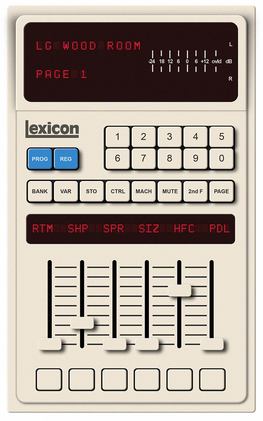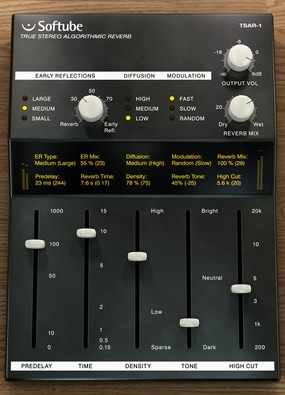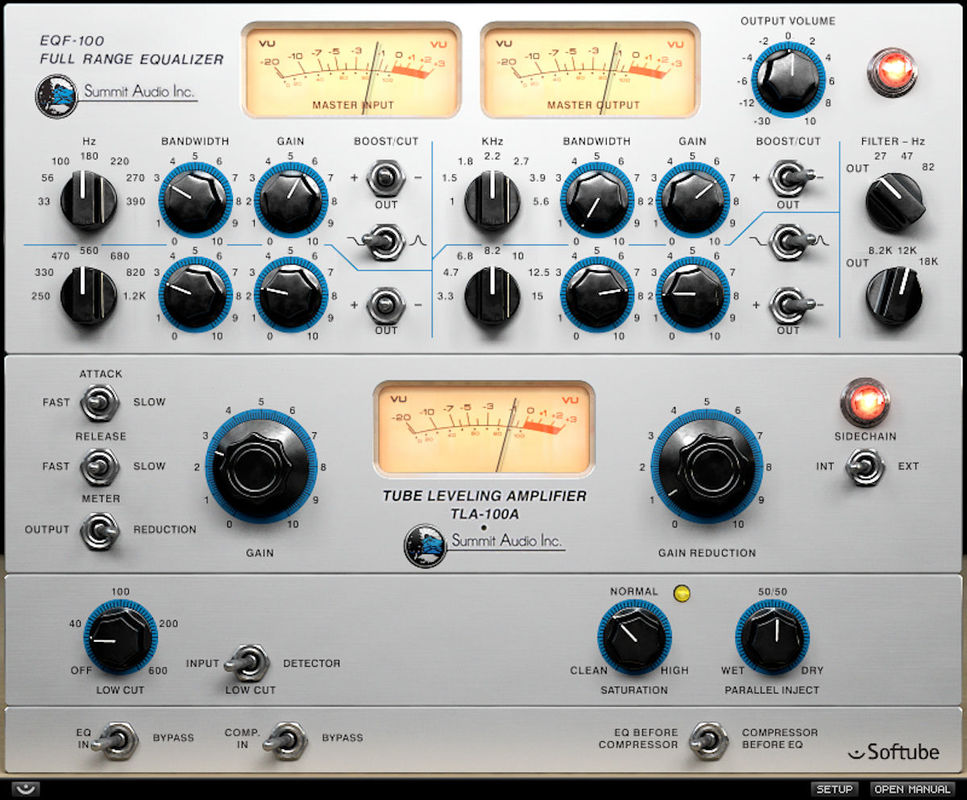Softube Volume 1 Review
In a manner of speaking, there are 16 of Softube’s most coveted plug-ins crammed into this collection. The mix and producing gamut is amply covered with kit pieces dedicated to Compression, EQ, Limiting, Summing, Amp simulation, Reverb, Delay, Echo, Flanging and Doubling/Chorus.
If that weren’t enough, Softube’s “Heartbeat” is an innovative, virtual drum machine that can handle most nearly any beat-making situation imaginable. Last, but far from least, the deluxe, expandable synthesizer, aptly named, “Modular”, attends a dizzying spectrum of flexible synthesis. Purchased separately, all the included accessories would set you back a little over $2000 (MSRP)! Thankfully, a perpetual (lifetime) license for this crate-load of plug-in glory can be had for a reasonable $499 (USD). Monthly and yearly subscriptions are also available - $20/month and $200/yearly respectively.
Overview
Softube’s “Volume 1” plug-in bundle was intently designed and packaged to address a number of crucial music production tasks. By Softube’s admission: they (Softube) have “identified the 11 most common situations in music production, such as creating drum machine and synth tracks, recording and mixing electric guitar, vocals or other acoustic instruments, and then adding the plug-ins needed to solve them. Volume 1 combines inspiring software instruments with studio-quality effects and tools to enhance the creative process.” Here’s a quick rundown of common, contemporary music production situations: - Vocal Mixing - Mix and Record Electric Guitars - Mix and Record Acoustic Instruments - Create Diverse Synth Sounds – ranging from classic analogue to those befitting house, trance, Hiphop and more. - Mix synths and keys (Rhodes, Wurlie, and etc.) - Mix Synth Bass and Bass Guitar - Create Dramatic Drums Sounds and Beats - Mix Electronic Drums - Mix bus processing “X:144” the professional Producer/mixer for Ms. Lauryn Hill, and game audio specialist at Electronic Arts is quoted as saying: “Volume 1 is a heavy hitter. The amount of vibe here makes it one of the most unique bundles available. The inclusion of Modular alone is insane.” Right – that’s enough PR for today. *Chuckle. As regards the bulleted list above, doesn’t it cite most home-producers’ requirements? Well, yes, of course it does. The point that Softube are emphatically trying to convey is that they feel their “Volume 1” bundle is more than an elementary collection of analogue-modeled processors. It goes without saying that Volume 1 is perfectly suited to classic recording genres. (IE: rock, country, jazz, gospel, and etcetera). It is also a potent mixture of audio-processing éclat capable of propelling electronic and modern pop productions with vibe-y style and finesse. This is largely due to the exciting sounds made possible with “Modular” synth and bodacious beats powered by “Heartbeat” – a modeled analogue synthesis of classic 80s drum machines. The lion’s share of the included effects plug-ins are officially sanctioned and licensed by the original hardware companies - namely: Drawmer, Trident, Summit Audio, Fix, and Doepfer. A few of the bundled components don’t make direct acknowledgement of any specific brand or famous device; however, they render sounds, visual appeal and control options indicative of well-known hardware heroes. The “FET Compressor” is such an example. It vaunts the biting attack and sonic luster of a vintage “UREI 1176”, but with the contemporary accruements of ‘wet/dry’ parallel compression, side-chaining and high/low pass filtering. Another case-in-point of nondescript citation is the impressive “TSAR-1” reverb. This one is visually reminiscent of early Lexicon hardware units - complete with intuitive sliders and knobs.
These offer just enough control to promote ease-of-use whilst keeping things simplified and speedy. It delivers lush, pleasing reverb tails and believable early reflections. Lex-styled chorus-y modulation is on tap, although it isn’t an exact reproduction of the famed ‘spin’ and ‘wander’. It’s not quite a Lexicon clone, yet it is a Lexicon-ish type of reverb appliance. I assay TSAR-1’s sound to be the offspring of a finely fitted marriage between a Lexicon 480L and an EMT 250 – just a little cleaner sounding, perhaps.
What’s Included?
Our friends at Softube promote “Volume 1” as a package containing 16 plug-ins. This is a true statement. What isn’t being promoted is that you don’t actually get 16 individual processors; it could be said that in its present form, the bundle only consists of 14 & ½ . One of which is a free download anyway – the “Saturation Knob”. As with many larger companies’ offerings in this vein, there might be a wee bit of hype in tow here. Why do I number the plug-ins at only 14 & ½ ? Well, the “Summit Audio Grand Channel” is a convenient combo plug-in comprising both the “EQF-100 parametric passive equalizer” and its compressor sibling, “TLA-100A Compressor” within a single plug-in. However, both of these are also individually part of the collection so I *mildly estimate this as a slight degree of redundancy. I won’t knock Softube too severely about this since the channel strip premise is a convenient all-in-one solution. Howbeit, conceivably it would be better value for the customer if the bundle included a couple of their other processors in addition to the “Grand Channel” by itself. This would increase the ‘real-world’ value and diversity of the bundle. Another little bit of “bundle filler” is evidenced by the inclusion of “TSAR-1r” – the affordable baby brother of the more fully featured “TSAR-1” reverb plug-in. The junior version of the reverb has it uses for realizing quick results, but I wouldn’t consider it an essential piece. As a guitarist, I would have appreciated the admittance of Softube’s “Spring Reverb” into the assortment instead. Of course, the “TSAR-1” (full version) may certainly be considered a necessary and principal component. Now that I have my neutralizing remarks out of the way, let me briefly introduce you to the products assembled in “Volume 1”. Seeing that I’ve already highlighted “TSAR-1” reverb, I won’t delve into it further – keeping our reader’s time and patience in consideration.
The first and last bands are filter-type selectable between bell shape and shelving. These operate in tandem with triple-position high and low cut switches; toggling between ‘Boost’, ‘Cut’ or ‘Out’.
The bands are adjustable, but only at fixed frequency points - as per original hardware design. Like most parametric EQs, this one also offers adjustable slope or “Q”. In contrast to more familiar “Q” controls, the range of frequency spectrum is adjusted with ‘bandwidth’ knobs. This is readily understood by those who use Pultec-styled EQs. Comfortably stationed below the equalizer, compression duties are secured by the authoritative, yett creamy-sounding “TLA-100A” leveling amplifier. It is my summation that this unit is Summit Audio’s response to the famous “Teletronix® LA-2A”. They share similar appointments and edict analogous workflow. As is typical for this type of compressor, the bulk of the work is handled with only two knobs – ‘Gain’ and ‘Gain Reduction’. It’s a rather simple workflow – turn up the gain to compensate for the amount of peak limiting being introduced. In addition, high-pass filtering can be applied to the input or side chain, while the ‘Parallel Inject’ (Wet/Dry) knob mixes between compressed and unprocessed signals. To culminate Softube’s 21st century augmentations, we have a ‘Saturation’ control for overdriving the output in a very harmonically pleasing way. By reason of this compressor being a ‘program dependent’ design, it yields exceptionally smooth, transparent volume leveling over a broad range of applications and program materials.
This kool, silver-plated design is a welcome deviation from the common black GUIs put forward by most competitors’ (similar) products.
Some folks might find the VU meters a tad sluggish, but the metering is attractive and effective. While not actually named after an 1176, the “FET Compressor” is a subtle, yet deliberate nod to the magnanimous UREI studio giant. Snap, ultra fast attack, and definitive sonic character are strong clues that it is carefully modeled on an 1176. Possibly, the modeled hardware was a 2nd revision unit from the latter 60s? What, with its silver panel and readiness to jump into saturation. *Grin. Typical 1176 attributes are here in spades, including the ever popular ‘ALL IN’ mode. Moreover, we’re generously supplied with built-in side chaining, mix/dry parallel processing, and high/low cut filtering. Is boominess on your bass track difficult to tame? No worries - just dial up the low cut on the compressor and your EQ-ing duties will be greatly simplified. Totting up the fresh performance value of “FET Compressor” is a convenient ‘Look ahead’ function – scalable up to (1) millisecond. It’s noteworthy to mention that compression ratio here is not configured using fixed degrees, as per the original 1176 design. In lieu of push buttons, adjustments are effected by a rotary knob, allowing the complete (continuous) range of in-between ratio values. And yes, as an exemplary 1176 ish clone does, this comp absolutely rockz on a drum bus, bass track, jumpy vocals and so forth. Insert plug-in. Point. Shoot. Take home the gold.
Trident A-Range: It’s reported that there were only thirteen “A-Range” consoles manufactured. Thirteen . . . lucky for us, I suppose. *Wink.
This one is definitely a ‘character’ EQ – it lives up to its reputation in that it can introduce all sorts of pleasantly unexpected harmonic surprises. It fairly oozes droplets of ‘vibe’ on vocal tracks, guitar tracks, snare channels, and pretty much anything else you want to bestow it upon. Once you begin to drive the front end, it tickles the audio source with sexy peach fuzz ‘hair’. I perceive A-Range as having an open, ‘air-y’ quality about it.
Four horizontal sliders facilitate primary EQ adjustments with a boost/cut range of 15dB in either direction. The frequency centers may be changed, but only at fixed values. High and low pass filter values can be activated using ‘push buttons’. There are three fixed assignments per filter – 9, 12 and 15Khz for low pass, and 25, 50 and 100hz pending the high pass. Finally, ‘Saturation’ circuitry is incorporated, according us sumptuous, harmonic saturation with a simple twist of the dial. Cranking this knob will gobble up a few more CPU cycles, but it can enhance some types of program material wonderfully. Otherwise, the Trident is very amiable towards a CPU.
Vintage Amp Room: Showcasing three, all-time favorite tube guitar amps in raw, vintage accuracy.
In contrast to many other amp sims, this one doesn’t attempt to emulate dozens of models – instead it faithfully nails the sonic frameworks of three iconic kings-of-tone. The amp models aren’t named after classic amps, but indulge me as I speculate: “Marshall JCM800 half-stack”, “Fender Deluxe Reverb” (minus the reverb), and a “Vox AC30”. These are referenced under the nomenclatures of ‘White’, ‘Brown’ and ‘Green’ respectively. The GUI is presented in a rich, warm hue, aptly matching the authentic, tube-like tones ready to be drawn out. Pleasant 3D-ish perspective invites play and tweaking. Each amplifier is accessed by drag/scrolling horizontally. Once your choice of amp is in view, its respective controls are located along the top of the GUI window.
Each of these three models positively emulates their respective hardware counterparts. Of particular interest is their ability to reproduce good tube-like clean tones – a feature sorely lacking in some of the competitions’ stocks. When extra gain is dialed in, it’s easy to forget you’re plugged in to a digital emulation. Big, gutsy tube tones muscle their way through the mix like Clapton’s ’65 Marshall Combo amp did on John Mayall’s Blues breakers’ cuts.
As the name of this plug-in implies, the attentive modeling is not based solely on the amplifiers’ componentry, but also studio room ambience and microphone placement. Repositioning the virtual mics results in obvious tonality changes and aural distance perspective – and very believably at that. Microphone distance and axis are both shiftable by varying degrees. Disappointingly, the amps don’t feature modeled spring reverb. This is particularly short-sighted on Softube’s part where the ‘Brown’ (Fender?) amp is concerned. After all, who ever heard of a classic dark-faced amp that didn’t have that trademark Fender reverb sound? Thankfully, the quality of amp simulation is otherwise exemplary so this faux pas can be forgiven. An apropos work-around would be to insert the deliciously ‘sproing-y’ Softube “Spring Reverb” into the chain, but unfortunately, it isn’t included in this bundle and costs an additional $99 usd (MSRP).
Basic, easy-to-dial-in controls are sensibly laid out along the top of the GUI window. Input volume, bass, mid, treble, master volume, and a high/low impedance switch are present and accounted for. There are, however, some differences worthy of examination.
The interesting, ‘extra’ stuff is located at the bottom of the interface where we find low & high cut filters, tilt-style tone control and a limiter knob. Rounding out the accruements is Softube’s handy-dandy parallel processing thing-a-ma-bob-a-roonie - they like to call it a ‘Direct Inject’ slider – which is actually a fancy-schmancy way of saying Dry/Mix control.
Continue on to Part 2 . . .
0 Comments
Your comment will be posted after it is approved.
Leave a Reply. |
NO SPAM! IK Multimedia Group Buy
FX Pick & Mix Group Buy - up to 16 for the price of 1
Will You Help?Web hosting is getting more and more expensive all the time, and Reviewer's Revival is NOT funded nor supported by any commercial enterprise or business. A donation of any amount is greatly appreciated. Even $2 or $3 for a coffee - every little bit helps. Thanks very much.
Legal BlurbAll of the articles published on Reviewer's Revival are undertaken to be purely objective, impartial reviews. Reviewer's Revival is not owned, funded-by, nor hired by any company or individual. Reviewer's Revival is the sole property of, and solely under the discretion and direction of Brother Charles. |












 15% OFF Summer Sale!
15% OFF Summer Sale!
 RSS Feed
RSS Feed

